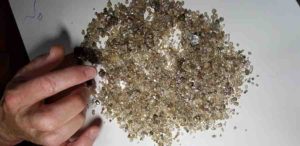
Analyses show that gases found in microscopic inclusions in diamonds come from a stable subterranean reservoir at least as old as the Moon, hidden more than 410 km below sea level in the Earth’s mantle.
Scientists have long suspected that an area of the Earth’s mantle, somewhere between the crust and the core, contains a vast reservoir of rock, comparatively undisturbed since the planet’s formation. Until now, there has been no firm proof if or where it exists. Now an international group of scientists has measured helium isotopes contained in superdeep diamonds brought to the surface by violent volcanic eruptions, to detect the footprints of this ancient reservoir. This work will be presented to scientists for the first time on Friday 23rd August at the Goldschmidt conference in Barcelona, after publication today (15 August) in the journal Science.
After the formation of the Earth, violent geological activity and extra-terrestrial impacts disrupted the young planet, meaning that almost nothing of the Earth’s original structure remains. Then in the 1980’s geochemists noted that in some basalt lavas from particular locations the ratio of the helium 3 to helium 4 isotope was higher than expected, mirroring the isotope ratio found in extremely old meteorites which had fallen to Earth. This indicates that the lava had carried the material from some kind of reservoir deep in the Earth, with a composition which hasn’t changed significantly in the last 4 billion years. “This pattern has been observed in “Ocean Island Basalts,” which are lavas coming to the surface from deep in the Earth, and form islands such as Hawaii and Iceland” said research leader Dr. Suzette Timmerman, from the Australian National University. “The problem is that although these basalts are brought to the surface, we only see a glimpse of their history. We don’t know much about the mantle where their melts came from.”
To address this problem, Timmerman’s team looked at helium isotope ratios in superdeep diamonds. Most diamonds are formed between 150 to 230 km below the Earth’s crust, before being carried to the surface by melts. Very occasionally some ‘superdeep’ diamonds (created between 230 and 800 km below the Earth’s surface) are brought to the surface. These superdeep diamonds are recognizably different from normal diamonds.
Suzette Timmerman said, “Diamonds are the hardest, most indestructible natural substance known, so they form a perfect time capsule that provides us a window into the deep Earth. We were able to extract helium gas from twenty-three super-deep diamonds from the Juina area of Brazil. These showed the characteristic isotopic composition that we would expect from a very ancient reservoir, confirming that the gases are remnants of a time at or even before the Moon and Earth collided. From the geochemistry of the diamonds, we know that they formed in an area called the “transition zone,” which is between 410 and 660 km below the surface of the Earth. This means that this unseen reservoir, left over from the Earth’s beginnings, must be in this area or below it.
“Questions remain about the form of this reservoir; is it a large single reservoir, or are there multiple smaller ancient reservoirs? Where exactly is the reservoir? What is the complete chemical composition of this reservoir? But with this work, we are beginning to home in on what is probably the oldest remaining comparatively undisturbed material on Earth,” she says.
Commenting, Professor Matthew Jackson (University of California, Santa Barbara) said, “There has been a lot of work focused on identifying the location of primordial reservoirs in the deep Earth. So this is an interesting result, with a lot of potential to “map out” where elevated 3He/4He domains are located in the Earth’s deep interior. Helium can diffuse rapidly at mantle conditions, so it will be important to evaluate whether the ancient helium signature reflects compositions trapped at diamond-formation depths, or the composition of the host lava that transported to diamonds to the surface. This work is an important step towards understanding these reservoirs, and points the way to further research.”
Reference:
S. Timmerman el al., “Primordial and recycled helium isotope signatures in the mantle transition zone,” Science (2019). science.sciencemag.org/cgi/doi … 1126/science.aax5293
Note: The above post is reprinted from materials provided by Goldschmidt Conference .










